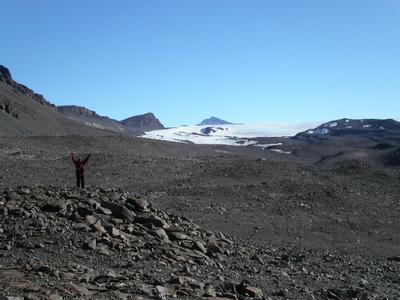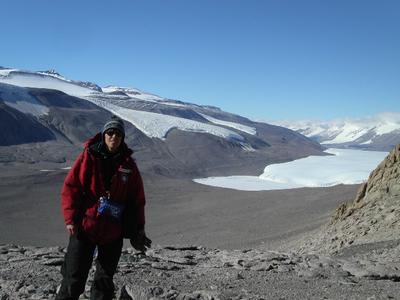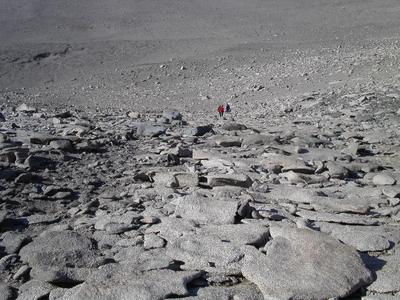27 January, 2003
Hiking And Exploring Pearse Valley
We set off this morning at 9:30 for a day of rock hunting, specifically
for gypsum and carbonates. Brenda did not anticipate that we would find much gypsum, if any, but searching for the unexpected is part of good research. We anticipated finding some carbonates, but were unsure of how much and at what locations.
Our guest for the day was Miranda Huston, from Antarctic New Zealand's Environmental Department. The team broke into two groups so as to cover more of the valley. Tom, Brenda, Sean, and Sarah set off along the northern side of the valley, while Aaron, Amber, Jake, Miranda, and I scoured the southern side.
It was a beautiful day. The temperature was down a bit and the winds blew a chill through us from time to time, but on the whole it was rather comfortable. We started from camp at the entrance to Pearse Valley and hiked up and down an endless number of PUDS (Pointless Ups and Downs) all day long. The terrain was often soft and my foot would sink deep into the sand with each step. Our team spread out in a line across the side of the valley and visually swept the slopes in search of rocks. We did not find gypsum, but found some samples we believe are carbonates. Regardless, we also enjoyed spotting all kinds of other rocks made of various minerals and shaped into all sorts of unique designs.
The highlight of the day however, was an exhausting diversion hike we took at about 4:30. We were high on the slopes near the end of the valley and began a 40-minute ascent up a very steep grade to the top of a saddle for a view into another valley. Part of the climb we had to scramble with our hands to maneuver over the layers of granite, carved into fragile plates by the blowing sand and wind. I often stepped on what seemed to be large flat boulders, but they would break under my weight because the underside had been eroded away leaving a cavity. Other rocks would simply shift or slide as you stepped upon them. They were fascinating to look at and beautifully delicate, but did not make for mindless hiking. We all had to be careful to step gingerly and to keep our weight leaning uphill in case we lost our balance or footing.
The view from the top of the saddle was of course amazing and worth every bit of breath I had gasped on the trek up and every aching twinge in my knees on the cautious descent. We were able to see what was basically the edge of the East Antarctic Ice Sheet. We stood at the top, took photos, and tried to grasp the concept of what we were looking out upon... the vastness that lay beyond, the solitude, the mesmerizing beauty, and the ability of the landscape to consume you. Once again I will post what I think are some amazing photographs. After viewing these pictures and then having stood above the valley captivated by the splendor of nature, I realize that sadly, the images do very little to capture the scene.
We hiked back down into the valley floor and continued collecting samples at the west end, working our way east towards Lake Joyce. Our group arrived back at camp at 7:00 pm having hiked a good seven or eight miles. Tired and hungry, we headed for the cook tent for hot drinks and dinner. We were pleased with the number of samples we had collected, and although it had made for a long day of hiking, we were also still filled with excitement from our hike up the saddle. I have found that spontaneous little jaunts, like the one we took today, are never disappointing in a land of such magnificence.

Celebrating a successful ascent up the saddle and a view into another valley.

This was shot at the top of the saddle looking back into Pearse Valley. That's the Cat's Paw Glacier in the mountains in the background. To the right in the photo is Lake Joyce and Taylor Glacier.

The Thinker: Jake having some fun posing on a ventifact (carved rock). I like the shadow he cast.

Layered rocks we crossed on our hike up the saddle.

From near the top of the saddle, looking down the slope of delicate weathered rocks.
Contact the TEA in the field at
.
If you cannot connect through your browser, copy the
TEA's e-mail address in the "To:" line of
your favorite e-mail package.
|
